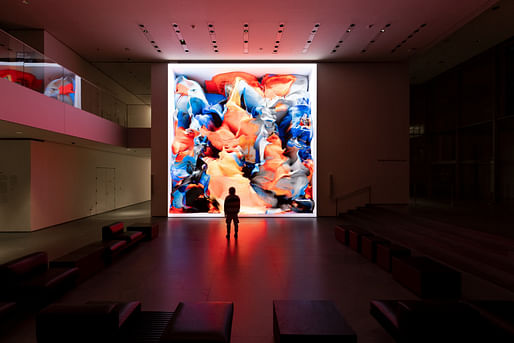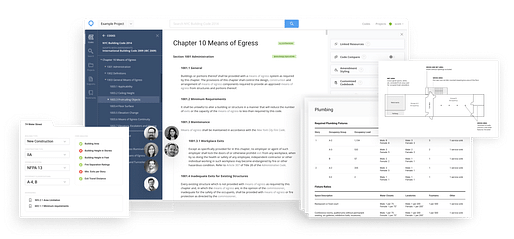

One of Archinect’s most significant editorial undertakings of 2023 was our Archinect In Depth: Artificial Intelligence series. Across the year, we spoke with over 30 experts in the field, producing dozens of interviews and features alongside almost 50 news stories covering the hyper-fast pace of progress emerging from the AI community.
The result is an all-encompassing, rigorous, and diverse collection of perspectives and reflections on what artificial means for the future of architects, architectural practice, and the architectural profession, along topics including ethics, labor, inequality, skills, and licensure.
Explore further insights on Archinect's leading coverage of architecture's relationship with artificial intelligence across 2023 below.
In May, we spoke with acclaimed architect and educator Behnaz Farahi on her work at the intersection of architecture, fashion, and computation. Farahi reflected on how emerging technologies can allow us to creatively explore the most pressing social and cultural issues of our time, from hierarchies and biases to objectification and bodily perception.
In May, architect Amanda Talbot offered us an insight into the journey of exploration that has led to the creation of Tilly, the "world's first AI designer," and the newest member of Talbot's Sydney-based practice Studio Snoop. We explored how and why Talbot created Tilly, how Tilly collaborates with her human colleagues, and where Tilly sits within Talbot's wider Bauhau-AI movement.
In May, we spoke with the writer, designer, historian, and professor Molly Wright Steenson to gain an understanding of the past, present, and future of artificial intelligence and its relationship with architecture and design. We also reflect on how advances in AI through the 2020s sit within the decades-long history of the field and how architectural practitioners and educators could engage with AI in their own work.
'AI Is Both Incredible and Terrifying'; A Conversation with Neil Leach
In June, we spoke with British professor and architect Neil Leach, who believes that conversations limited to popular AI tools such as Midjourney and ChatGPT detract from a broader reckoning that the architecture profession must have in the face of ever-more-capable AI models and platforms. For Leach, this AI-induced reckoning includes, though is not limited to, the supply and demand of architectural labor, liabilities, and insurance, and the future of all pillars of the architectural community, be it practice, academia, or licensure.
'AI Is Built on Datasets That Are Already Biased'; A Conversation with Felecia Davis
In June, acclaimed architect and educator Felecia Davis spoke to us on the question of how computational textiles could intersect with and challenge social, cultural, and political constructions. We explored how Davis’ interests in computation and textiles emerged, how the two interests manifest in her work today, and how her Penn State lab’s ‘soft system’ joins wider efforts to confront biases, discrimination, and disempowerment in both artificial intelligence and society at large.
'AI Could Be Seen as a Culture of Death in Its Darkest Sense'; A Conversation with Genevieve Goffman
In June, we spoke with New York-based artist Genevieve Goffman on her eclectic work in fantasy and narrative world-building, often explored through the medium of evocative and ornate 3D printed sculptures derived from digital modeling. We also reflect on the relationship between technology and culture in her work, as well as her thoughts on the relationship between designers and critics.
In June, we spoke with speculative architect Liam Young about his career across design and media, as well as his views on artificial intelligence, climate change, and the role of the architect in addressing both topics. Young stressed the vital need for a creative discipline that measures the dangers of AI against those of climate change: A crisis which Young sees as more dangerous both for its scale and deceptive ubiquity.
In June, architect and TED founder Richard Saul Wurman gave us his reflections on artificial intelligence and how it sits in a broader timeline of technology and innovations. We also discussed how AI intersects with Wurman's passion for making information understandable and accessible and Wurman's wider thoughts on how his architectural background, his engagements with Louis Kahn, and his fascination with "opposites" have and continue to shape his career.
In June, we spoke with visual artist Alexis Christodoulou about his career in 3D visualization, including his background, process, tools, and thoughts on how artificial intelligence intersects with his field. We also chart the artist’s journey from its simple architectural beginnings to vivid, minimalist experiments in Modernism, Brutalism, and the natural world, to present-day commissions by luxury brands.
In June, ecoLogicStudio founders Claudia Pasquero and Marco Poletto offered us an insight into their professional and academic careers at the intersection of computation and biology, which allows them to articulate a vision of artificial intelligence that, in their words, "is more like a slime mold, a spider's web, a microalgae colony, or a mycelium network.” Having won wide acclaim for their real-world applications of ecological systems in the built environment, the studio also articulates more futuristic visions that "shake us from our anthropocentric indifference to the beautiful intelligence of our living planet.”
AI Bias and Digital Colonialism; A Conversation with Morehshin Allahyari
In July, we spoke with artist Morehshin Allahyari about her life, work, and reflections on the relationship between technology, architecture, and power relations. Using 3D simulation, video, sculpture, and digital fabrication, Allahyari warns us of a modern landscape in which power dynamics straddle both digital and physical worlds, articulating her theory of Digital Colonialism as a "framework for critically examining the tendency for information technologies to be deployed in ways that reproduce colonial power relations."
Storytelling, Bias, and Exploitation in Digital Realms; A Conversation with Miriam Hillawi Abraham
In July, Ethiopian designer and researcher Miriam Hillawi Abraham described to us how digital media can be an impactful, playful, and unrestrained way of shaping immersive stories that challenge Western narratives and power dynamics imposed on the African continent, its histories, its built environment, and its people. Meanwhile, Abraham also sounded a timely note of caution on the potential for digital technologies and artificial intelligence to generate a single, incomplete visual language for the future.
Narrative, Media, and AI in Architectural Academia; A Conversation with Natasha Sandmeier
In July, we spoke with UCLA AUD Entertainment Studio lead and A+D Museum executive director Natasha Sandmeier. Sitting at the forefront of the architectural academic landscape, Sandmeier asks what the recent popularized adoption of AI in design and world-building means for authorship, ethics, representation, learning criteria, and the role of the architect.
Design, Computation, and Humans: Exploring the Intersection with Onur Yüce Gün
In July, computational designer Onur Yüce Gün explained to us how an architectural background brought him to his current position as the Director of Computational Design at the global footwear brand New Balance. Gün also sets out the power of blending the hard-won 'generalist specialist' skill of the human designer with the unprecedented power of AI and computation to unlock new scales and resolutions for us to explore, sculpt, and craft.
AI, Complexity, and Ecological Futures: A Conversation with Alisa Andrasek
In July, designer and educator Alisa Andrasek offered us an insight into her acclaimed work at the intersection of art and science. Describing cities as "the most complex constructs humanity has ever created," Andrasek sees artificial intelligence, computation, and mathematics as a vehicle for delivering urban and infrastructural environments that respect the planet while instilling a sense of "wonder and discovery" in both designers and citizens alike.
You, Me, and DALL-E: On the Relationship Between Architecture, Data, and Artificial Intelligence
In May, we kicked off our Archinect In-Depth: Artificial Intelligence series with an introductory look into the AI landscape of 2023, fuelled by new developments in generative tools from Midjourney to ChatGPT. In our search for answers, we also spoke with University of Michigan researcher and SPAN founder Matias del Campo on how designers can unlock this newfound potential of machine learning.
Autonomous Algorithmic Architects: Wicked Problems of Machine Learning in Architecture
In May, Architect and Yale School of Architecture Associate Dean Phil Bernstein reflected on the opportunities, threats, and resulting strategies for the confluence of human and machine intelligence in architecture. Bernstein asked how the architectural profession can propose a willful, designed route that acknowledges the inevitability of intelligent machines intersecting with every dimension of design and construction while maintaining a proper role for human architects.
The Illusion of Space: Can Artificial Intelligence Understand the Third Dimension?
In May, researcher, author, and academic Amanda Wasielewski used the AI discourse to unpack relationships at the heart of design, representation, and space: that of human versus machine 'understanding,' of two versus three dimensions, and of chaos versus creativity. Wasielewski also asks what the role of text-to-image generators can be as tools in the architecture and design arsenal.
ChatGPT Interviews Matias del Campo: Architecture, Hallucinations, and other Exotic Occurrences
In May, Matias del Campo allowed himself to be interviewed by ChatGPT on his background in artificial intelligence and his thoughts on its future application to the design process. In the piece, del Campo stressed that it is important to note that artificial intelligence is not a replacement for human creativity and expertise.
New Dog, New Tricks: Reflections on Construction, Robotics, and Artificial Intelligence
In May, we asked what the current relationship is between humans, robotics, and construction, and what its future will be. To help us explore such questions, we spoke with both Boston Dynamics and the Applied Research + Development group at Foster + Partners for their experiences and perspectives in designing, building, and applying the latest innovations in robotics on construction sites.
When Form Follows Meanings: AI’s Semantic Turn in Architecture
In June, Stanislas Chaillou argued that AI’s dissemination in architecture may refocus the profession’s attention on the importance of semantics as a way to describe and design the built environment. Chaillou offered Semanticism as a new name and direction to the practice of architecture, reflecting the conviction that AI-supported design abides by the principle of ‘form follows meanings.’
Throughout the year, our in-depth features and interviews were complemented by ongoing news coverage of the fast-paced cycle of innovations, developments, and debates taking place at the intersection of AI and architecture.

In May, for example, Princeton and IE University unveiled a vaulted brick pavilion using AI, while Boston Dynamics’ robot 'dog' Spot was equipped with ChatGPT to allow conversations with human companions. Later in the month, Autodesk unveiled Forma, an AI-driven tool for generating and analyzing BIM models, while OpenAI’s new 3D model tool Shap-E showed how text-to-3D printing may soon be a reality.

Alongside globally-known tech companies such as Autodesk and OpenAI, lesser-known startups also made a big impact in the AI space. SWAPP raised $11.5 million for a tool that offers "AI-powered construction documents in minutes," while code compliance platform UpCodes launched an AI assistant and raised $3.5 million. In July, meanwhile, Stability AI launched a free sketch-to-image tool, while in September, Rayon unveiled a Norman Foster-backed design tool for developing architectural plans.

Some of the design industry’s biggest names also captured AI headlines throughout the year. In June, Zaha Hadid Architects offered the New York Times an insight into how the firm has deployed artificial intelligence in the workplace. One month earlier, meanwhile, Norman Foster told the AFP of his reservations about the role of artificial intelligence in architecture. Elsewhere, Refik Anadol’s Machine Hallucinations generative AI piece was acquired by MoMA.

Taking note of the future potential for AI to impact the labor market, meanwhile, the White House sought the public’s help on AI risks to labor conditions, while New York City announced it would enact a law on how AI can be used when hiring.

The launch of our new series, Archinect In-Depth: Artificial Intelligence, offered us the opportunity to return to our existing Archinect’s Lexicon series, which focuses on newly invented (or adopted) vocabulary within the architectural community. From ‘prompt engineer’ to ‘generative design’ and ‘ubiquitous computing’ to spatial computing’, we encourage our readers to explore the series in parallel with our extensive publishing with the Archinect In-Depth series.
Shout-out to Archinect's newest editorial team member, Synthia Wordsmith, for all her hard work generating definitions for our lexicon.

In tandem with our deep explorations of AI, our ‘Generative Futures: AI + Architecture Storytelling Challenge’ offered readers a vehicle to set out their vision for the future relationship between AI and architects, architecture, and the profession. We challenged our community to develop creative and original submissions, welcoming various storytelling formats and genres, such as allegories, love stories, horror stories, diary entries, or data-driven predictions.

The competition was judged by a star jury: Refik Anadol, Sandra Manninger, Laure Michelon, Michael Begler, Kordae Henry, and Rene Peralta. After careful deliberation, the competition jury selected a Top Prize winner and four honorable mentions from each category: The AI-infused city; The AI-infused architecture studio; The AI-infused construction site; and the Open Category: entrants may define their own theme as it relates to AI and architecture.
Explore the winning entries here.
Be sure to follow Archinect's special End of the Year coverage by following the tag 2023 Year In Review to stay up to date.
No Comments
Block this user
Are you sure you want to block this user and hide all related comments throughout the site?
Archinect
This is your first comment on Archinect. Your comment will be visible once approved.